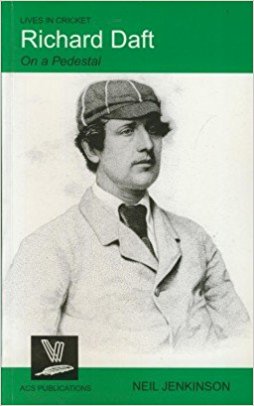Richard Daft: On a Pedestal
Martin Chandler |Published: 2008
Pages: 147
Author: Jenkinson, Neil
Publisher: ACS
Rating: 3 stars

Perhaps it’s the legal training we have in common, but I do like the way Neil Jenkinson writes. There is nothing flamboyant about his work, but it is concise and easily understood, as you would expect from someone who has spent their working life in the business of providing people with explanations.
The first book of Jenkinson’s that I read was his biography of the prodigious Hampshire batsman Phil Mead. It is a book that Archie reviewed some time ago and was not terribly impressed by. I cannot disagree with Archie’s comments about a book I have only ever used as a reference point. That should not reflect badly on the author however.
As the fourth highest First Class run scorer in history Mead needed to have his biography written, although it was never going to be an exciting read. Mead was a skilled artisan, interested solely in the accumulation of runs, something he did consistently for Hampshire for years and years. He was never an England regular but still averaged just a tick under 50 in his 17 Tests. Controversy and Mead seldom crossed swords, and his life story was always destined to be fairly pedestrian.
With Richard Daft, Jenkinson brought his skills to bear on the life of a much more interesting character. Unfortunately, albeit for rather different reasons, he has similar problems. On this occasion the issue is that Richard Daft simply comes from too far back in history for Jenkinson to do much more than gather together what we already know of his subject from a wide variety of sources into a seamless story.
A contemporary of WG Grace, although some way behind the great champion of course, Daft was one of the best batsmen of his time and had Test cricket been born a decade earlier might well have played for England. Plenty of the 254 First Class matches in which he played were widely reported on, as were a not inconsiderable number of minor matches. As all good lawyers are Jenkinson is a careful researcher, and I have every confidence in his having discovered all that there is to find, but that does tend to lead to a good deal of writing about cricket matches which, were other material available, might have been jettisoned.
One match that is reported in some detail and, sadly, is of even more interest now than when Jenkinson’s book was published, is the MCC v Nottinghamshire match in 1870. It was then that, on one of the notoriously poor Lord’s pitches of the day, fast bowler John Platts felled Nottinghamshire’s George Summers. Four days later Summers died, only to be forgotten until over 140 years later a similar fate befell another 25 year old, Australian Test batsman Phillip Hughes. Daft, Notts captain in 1870, had gone in as Summers left the crease. He did so wearing a towel around his head in an effort to mark his concern at the state of the wicket.
Outside the game Daft was an interesting man. He was born into poverty before, as a young adult, an inheritance from a wealthy relative changed his life. He began playing the game as an amateur, although he later turned professional. To play for both sides in Gents v Players matches is in itself unusual.
Daft was also a businessman. He married into the brewing business and was a publican. He also had a sports outfitting business in his own right. None of his business interests ran consistently smoothly but he had his successes as well as his disappointments. Eventually, however, the rags to riches story was reversed, and Daft was bankrupted.
There was some interest in bibliography in Daft’s life as well. His Kings of Cricket was published in 1893 and sold very well. It was one of the first cricket books published in a limited edition. Later, 26 years after his death in 1900, his literary legacy was mined again for another book, A Cricketer’s Yarns.
In conclusion Richard Daft: On a Pedestal is certainly worth its place in the ACS Lives in Cricket series. It is required reading for anyone with an interest in WG and his life and times, although it may not appeal to too many others.






Leave a comment